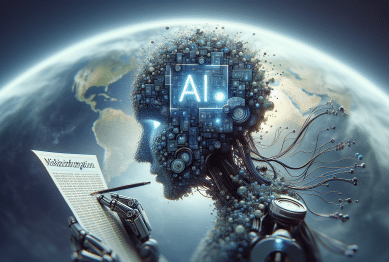Explore how news about artificial intelligence shifts public perception, influences industries, and often defies expectations. This guide delves into the way technology headlines become part of daily life and what these ongoing updates reveal about tech’s future.
The Influence of Artificial Intelligence Headlines
Almost every day, headlines about artificial intelligence spark curiosity and sometimes even anxiety. These articles can dramatically change the narrative around emerging technology. As more AI advancements reach the public eye, people begin to see possibilities—and challenges—that weren’t imagined just a decade ago. News sites and major media players have recognized that artificial intelligence content hooks readers by blending possibility with unpredictability. It makes a complex field more relatable. When AI powers new health research, smart assistants, or personalized news feeds, headlines offer readers both inspiration and concern in equal measure. Industries that were slow to embrace technology, including newspaper publishers and local TV, now highlight AI-driven trends to stay competitive. Through news cycles, AI begins to shape not only consumer expectations but meaningful political debates as well. This symbiosis between newsmakers and technology helps frame much of the world’s digital transformation.
What often surprises the public is the speed at which new artificial intelligence technologies move from concept to real-world application. A news story might feature a breakthrough one week, and only a short time later, the same innovation is being used in hospitals, classrooms, or security systems. Such stories tap into main keywords like ‘machine learning’, ‘automation in newsrooms’, and ‘AI-generated content’. Newsrooms that cover these developments regularly also explain the difference between hype and reality. By providing background, reputable outlets help individuals and organizations set realistic expectations. This context matters for investors, educators, and policy-makers alike, all of whom increasingly depend on accurate, timely information to guide their next steps in a quickly changing environment.
Despite growing awareness, confusion can arise around what artificial intelligence can and cannot do. Some headlines cause alarm because they oversell risks or suggest a level of autonomy computers haven’t achieved. It’s not unusual for AI news to prompt debates over job displacement or privacy. However, well-researched articles demystify the science and clarify common misconceptions, such as the difference between narrow AI (where a system excels in a specific task) and generalized intelligence (which is still a distant goal). Credible news outlets also help expose bias in algorithms—an urgent topic as artificial intelligence becomes more involved with everything from hiring practices to criminal justice. In this way, AI news acts as both watchdog and educator, shaping more informed digital citizens.
How Artificial Intelligence is Changing Media Itself
It’s no secret that artificial intelligence is now influencing not just the content reported, but the very way media is produced and distributed. Major outlets rely on AI to scan massive datasets, generate real-time updates, and even personalize news feeds for individual preferences. This blend of automation and human curation increases efficiency for editors and enhances the user experience. For instance, machine learning algorithms summarize major events, allowing breaking news to reach readers faster. Behind the scenes, tools powered by natural language processing sift through press releases and user-generated content, prioritizing stories based on predicted reader interest. While some worry automated reporting could reduce newsroom jobs, studies suggest AI more often handles repetitive work, freeing up journalists to focus on investigative and analytical pieces instead.
With more content flowing through digital channels, issues around credibility become more complex. AI tools can flag misinformation, fact-check claims, and even detect deepfakes—computer-generated images or videos designed to mislead. Newsrooms that leverage these tools are better equipped to defend against hoaxes and malicious actors. At the same time, the industry grapples with the risk of algorithmic bias and the challenge of making automated systems transparent and accountable. AI-driven news recommendations can shape echo chambers if not carefully calibrated. Leaders in media encourage diverse data sources and frequent evaluation of automated tools to avoid reinforcing stereotypes or accidentally silencing minority voices. This ongoing evolution means readers, too, must develop literacy to question how the news they see is created and selected.
Artificial intelligence also revolutionizes the advertising and business side of media outlets. Automated systems match ads to articles more precisely, increasing revenue opportunities but also raising questions about privacy and data use. Real-time analytics help publishers understand what resonates with audiences, enabling more relevant content and sustainable business models. However, many experts emphasize the need for transparent data practices and open dialogue around privacy rights. By balancing these priorities, leading media organizations aim to develop a digital news ecosystem that is both trusted and innovative. This dynamic relationship between news production and new technology will continue to evolve, shaping how people connect with both information and each other.
AI Trends That Capture Public Attention
Certain developments in artificial intelligence consistently draw widespread public attention. For example, breakthroughs in generative AI—including tools that craft images, write text, or compose music—tend to capture imaginations across industries. These stories often spark debates about creativity, intellectual property, and the redefinition of original work. In education, teachers and students rely on AI-powered systems for personalized learning, while researchers look to artificial intelligence for new insights in biology or climate modeling. As AI integration deepens in these areas, news coverage offers relatable examples, helping readers understand both the benefits and complexities.
Another recurring topic is the ethics of artificial intelligence. News reports highlight controversies around facial recognition, algorithmic decision-making, and surveillance. These stories bring in perspectives from policy-makers, ethicists, and civil society groups. Such reporting helps people engage with difficult questions—like how to ensure transparency in automated systems or how to safeguard against biased outcomes. Many outlets now dedicate special sections to the intersection of AI and social justice, emphasizing increased accountability. By tracking these trends, news consumers stay informed about evolving concerns and the development of new frameworks intended to address them.
Beyond hot-button issues, readers are often intrigued by human-AI partnerships that solve real-world problems. Headlines featuring collaborative robots in factories, smart diagnostic systems in medicine, or AI-powered translation services for global communication present a hopeful view of technology. These stories encourage optimism while remaining realistic about challenges. By incorporating feedback from both users and experts, news coverage demystifies how artificial intelligence systems perform in practice. As a result, readers gain practical tools for evaluating future stories and innovations in the tech space.
The Role of Misinformation and Fact-Checking
With artificial intelligence fueling rapid news production, misinformation can circulate as quickly as breaking stories. Newsrooms and independent organizations increasingly use automated tools to identify and correct false claims. These systems compare suspicious posts with externally verified facts and flag anomalies for human review. As fact-checking software becomes more sophisticated, it can adapt to new types of disinformation—like altered videos and deepfakes—helping preserve the integrity of public discourse.
The importance of media literacy grows as fake news becomes harder to spot. Many journalism schools and nonprofit organizations now offer educational programs teaching people to recognize misleading narratives, verify sources, and understand digital footprints. This investment in literacy is crucial for maintaining trust in news. Through open-source tools and cross-platform networks, fact-checkers collaborate globally to strengthen resilience against coordinated misinformation campaigns. Public knowledge about these efforts in turn supports more discerning consumption of news, especially in fast-evolving fields like artificial intelligence and health technology where errors can have large consequences.
Despite these advances, challenges remain. Automated systems still make mistakes or reflect the biases of their designers. Independent review by human experts is necessary to ensure accurate corrections. By balancing technology with transparent editorial oversight, the media industry can respond to both new threats and emerging opportunities. This partnership reinforces the news as a trusted channel—one capable of navigating complexity in the digital era.
Your Role in Navigating the Digital News Era
Individual readers now play an active part in the news cycle. With so much information at their fingertips, people must develop strategies for evaluating credibility and relevance. Understanding how artificial intelligence shapes both the stories covered and the way they are shared is a practical first step. Following guidelines on analyzing sources, reading beyond headlines, and cross-checking facts helps avoid falling prey to viral hoaxes or algorithmic echo chambers.
Engaging critically with news also means contributing feedback when errors appear or when reporting is unclear. Many outlets provide comment sections, direct contact options, or even ombudsman services for addressing concerns. Community-driven reporting projects invite people to suggest story ideas or provide local context for national trends. This two-way communication makes news more responsive and attuned to real concerns, especially as artificial intelligence systems increase the speed and variety of stories people receive each day.
Finally, individuals can seek out media literacy resources and become advocates for responsible news consumption in their own communities. Sharing reliable articles, explaining scientific advances to others, and supporting ethical journalism strengthens the integrity of the entire digital information ecosystem. In a world where artificial intelligence continues to accelerate the pace of news, informed readers keep public conversation grounded, balanced, and open to discovery.
References
1. Pew Research Center. (n.d.). Artificial Intelligence and the News. Retrieved from https://www.pewresearch.org/journalism/2019/09/23/artificial-intelligence-and-the-news/
2. Columbia Journalism Review. (n.d.). How AI is Transforming Newsrooms. Retrieved from https://www.cjr.org/innovations/how-ai-is-transforming-newsrooms.php
3. NiemanLab. (n.d.). What AI Means for Local News. Retrieved from https://www.niemanlab.org/2022/10/what-ai-means-for-local-news/
4. NewsGuard. (n.d.). Fighting Misinformation with AI. Retrieved from https://www.newsguardtech.com/special-reports/fighting-misinformation-ai/
5. Knight Foundation. (n.d.). The Rise of Automated Journalism. Retrieved from https://knightfoundation.org/reports/automated-journalism/
6. International Fact-Checking Network. (n.d.). Fact-checking and Tech. Retrieved from https://www.poynter.org/ifcn/









